|
| Page: [Previous] [Next] 1 2 |
| (1) Posted by Sarah Hornecker [Monday, Jul 30, 2007 21:12]; edited by Sarah Hornecker [07-07-31] |
What happened to Mikhail A. Zinar?
What happened to Mikhail Afanasjevich Zinar?
I'd like to know it since he was a composer of many beautiful pawn endgame studys.
If you even can provide me with an address or other means of contacting, this would be phantastic!
Best thanks,
SH
PS: According to Rainer Staudte's database he was born in Ukrain, not in Soviet Union as I always thought. He may also be known as Michail Zinar. [I'm wrong, see reply of YA below]
|
|
| (2) Posted by Yochanan Afek [Tuesday, Jul 31, 2007 00:48]; edited by Yochanan Afek [07-07-31] |
I have also been eager to find out what had happened to this virtuoso of the pawn endings. Sorry I can't be much of a help Just to offer a small correction: perhaps you are a bit too young to know that Ukraine was in fact part of the Soviet Union and quite an important one.
|
|
| (3) Posted by Sergiy Didukh [Tuesday, Jul 31, 2007 16:58] |
In 1995 Mikhail Afanasievich Zinar moved from Crimea to a little village Gvozdavka-2 in Odessa region (300km from Odessa). He taught labour discipline at school. In 1997 S.N.Tkachenko came to see him and M.Zinar told him he abandoned composition because of financial difficulties. Those were really hard times for Ukrainian people and especially for teachers. They were paid 10-20 dollars a month.
A little later M.Zinar prematurely died.
|
|
| (4) Posted by Sarah Hornecker [Tuesday, Jul 31, 2007 17:07] |
So the riddle finally is solved, though very sad. Many thanks!
|
|
| (5) Posted by Yochanan Afek [Tuesday, Jul 31, 2007 19:56]; edited by Yochanan Afek [07-07-31] |
Thanks to Sergey for this sad information. Siegfried, can you perhaps introduce here a couple of Zinar's best pawn miniatures to demonstrate his great artistic skill?
|
|
| (6) Posted by Sarah Hornecker [Wednesday, Aug 1, 2007 00:54] |
World has lost the greatest composer of pawn endgames that ever has lived on this planet (even greater than Kling & Horwitz). So (on request of Yochanan Afek) to the memoriam of him here are five (of his sadly only 285) studies.
It is a great honor to me to officially choose some of the best studies of Zinar. Fact is, I can't choose just the best since it would be too many so I concentrate on some interesting but simple ones.
Now if you tell me everyone could have composed this, let me tell the story of a spanish adventurer.
After his journey to what he thought was Cipangu and Kathei (today called Japan and India) the spanish queen wanted to speak to him. She and her advisors told him, everyone could have done that journey and there wasn't anything special about it. Well, the seaman took an egg and asked the people to make it stand on the table. The advisors tried hard but eventually gave up. They told the sailor it is impossible to stand an egg. Now the great hour of the seaman had come: He took the egg, pressed it against the table until it was pushed in enough to let it stand on the table without further means. The advisors told him, everyone could have done this but the seaman just replied: "Yes, maybe everyone could have done this but nobody had thought about it. Thinking counts! Good evening, gentlemen!" (other sources say: "Yes, maybe everyone could have done this but I did it! Good evening, gentlemen!") Well, just one side not to this story. The true destination of his travel became known around 11 years later. He failed in reaching Cipangu and Kathei. Most of you will surely know who was the seaman but in case you don't know yet: It was Amerigo Vespucci who prove that the seaman did not reach his destination but a new land that has not been cartographed before. To the honor of Vespucci the land is still called - even today - America and the seaman was Christoph Columbus. Well, that anecdote sadly is not true but it as well could have been. The trick always since has been referred to as the egg of Columbus. (Note: how to do the trick without pushing in eggs can be seen at http://davidwonn.kontek.net/equinox.html - it doesn't only work on equinox, though)
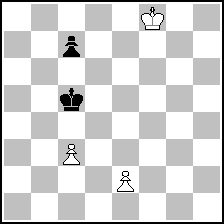 (= 3+2 ) (= 3+2 )
M.A. Zinar
Shakhmaty v SSSR 1981, special prize
Draw
Now this is a study I love very much. Despite only having five pieces on board, it is perfectly made. I'm in doubt anyone could win this endgame in OTB who doesn't know this study. I copy the analyses from my website (taken from hhdbiii there), also my comments (translated by me).
After trying all normal moves, but noticing they won't get you anywhere, you can be desperate. The study seems incorrect and one may wonder if the diagram is wrong or what happened. Has something been overlooked? One checks again and again...
1.Ke7? Kc4 2.Ke6 Kxc3 3.Kd5 Kb4! 4.e4 c5= oder 2.e4 Kxc3 3.e5 c5 4.Kd6 c4 5.e6 Kb2 6.e7 c3 7.e8D c2=
1.e4? Kd6=
1.Kf7? Kd5! 2.Kf6 Kc4 3.e4 Kxc3 4.e5 c5 5.e6 Kd2 6.e7 c4 7.e8D c3=
But what can be the solution then? It can't be zugzwang since 1.Ke7? and 1.Kf7? both lose. Well, one only can find the solution by noticing white would win if in the last variation 2.Kf7 would be possible. So it becomes clear that the most idiotic and slowest move in reality is the most brillant and fastest move.
1.Kg7!! Kd5/i 2.Kf7! Ke5/ii 3.Ke7 Kd5 4.Kd7 Kc4 5.Kc6! Kxc3 6.Kc5
i - 1...Kc4 2.e4 c5 3.e5 Kd5 4.Kf6
ii - 2...Kc4 3.e4 Kxc3 4.e5 c5 5.e6 Kd2 6.e7 c4 7.e8D c3 8.Dd8+
That's the strange chess board geometry where the slowest way can be the fastest and a diagonal is as long as a straight path.
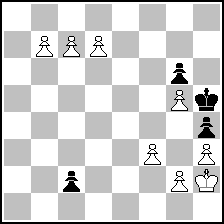 (= 8+4 ) (= 8+4 )
M.A. Zinar
Shakhmaty v SSSR 1983, special HM
Black to move, white wins
One just can wonder how many miracles are still waiting in pawn endgames if this only has been found so recently! Is even an Allumwandlung possible (here Zinar showed 1xQ 2xR 1xB)?
1...c1Q 2.c8R! Qb2 3.b8B! Qd4 4.d8R! wins
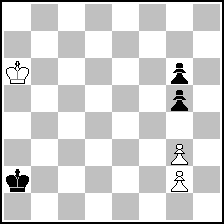 (= 3+3 ) (= 3+3 )
M.A. Zinar
64-Shakmatnoe Obozrenie 1984
Win
This maneuvre (although I think not exactly this study) made it into one of the three must-have books about endgames (Dvoreckij's "Endspieluniversität", I think it's called something like "Endgame University" in english).
1.g4! Ka3 2.Ka5! Kb2 3.Kb6 Kb3 4.Kb5! Kc2 5.Kc6 Kc3 6.Kc5 Kd2 7.Kd6 Kd3 8.Kd5 Ke2 9.Ke6 Ke3 10.Ke5 Kf2 11.Kf6 Kg3 12.Kxg5! wins
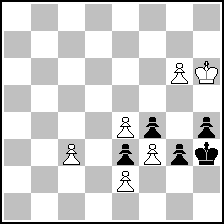 (= 6+5 ) (= 6+5 )
M.A. Zinar
Magadanskaja Pravda 1986, hm
Win
This is also a theme Zinar seems to have done much research in
1.g7 g2 2.g8R! Kh2 3.Kh5 h3 4.Kh4 g1Q 5.Rxg1 Kxg1 6.Kxh3 Kf2 7.e5 Kxe2 8.e6 Kxf3 9.e7 e2 10.e8R! wins
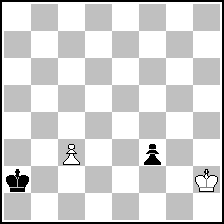 (= 2+2 ) (= 2+2 )
M.A. Zinar
Shakhmatnaja Kompozitsia 1995
Win
This one looks familiar, but it's still different from it's predecessors.
1.c4 Kb3 2.c5 Kc4 3.c6 Kd3 4.c7 f2 5.c8Q f1Q 6.Qa6+ wins
Well, the other 280 studies are left for your own exploration. ;o)
|
|
| (7) Posted by Yochanan Afek [Wednesday, Aug 1, 2007 10:06] |
Great stuff, Siegfried, thanks! Zinar indeed deserved better for his unique contribution to chess culture.
|
|
| (8) Posted by Hauke Reddmann [Wednesday, Aug 1, 2007 11:14] |
Since Siegfrieds analysis doesn't "explain" the mystery
of the 1st study properly, I'll add.
The key point of the study is that Kf6 Qe8/Kd2 Pc3 is drawn,
even though White has the move and the P is still on row 3.
Coda: The K stands in the way on f6. (The position is unique
and surely known long before Zinar. Which of course doesn't chip
off a thing from the sensational key Kg7!!) And from this fact
stems a mutual Zugzwang with Kf7/Kd5 which forces Whites
1st move.
Hauke
|
|
| (9) Posted by Arpad Rusz [Wednesday, Aug 1, 2007 22:38] |
Do you know that the 10th chapter of Averbach's "Pawn Endgames"(The Theory of the Corresponding Squares) was written by M.Zinar!
There are many original studies by Zinar in that chapter. Here is one of them, with symmetry-asymmetry:
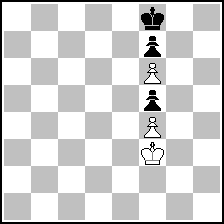 (= 3+3 ) (= 3+3 )
win
In 1990 Zinar has published a book about pawn studies:
Zinar, Archakov: "Harmonia peshetshnovo etyuda"(The Harmony of the Pawn Studies).
|
|
| (10) Posted by Sarah Hornecker [Thursday, Aug 2, 2007 02:57]; edited by Sarah Hornecker [07-08-02] |
The following study still holds the world record for the longest not-promoting pawn endgame where the black king moves to more than two fields (as in Van_Dijk 1968, Reichhelm 1913 or Bláthy 1890 where the kings are bound by promotion threats). It is one of only seven pawn endgames longer than 30 moves. I wonder why it never appeared in the endgame literature.
 (= 8+7 ) (= 8+7 )
Mikhail Afanasjevich Zinar
Shakhmaty v SSSR 1977, special prize
1.Ke2 e4 2.c4 Kg8 3.Kd2 Kf7 4.Kc3 Ke6 5.Kb3 Kd6 6.Ka4!/i Kc6 7.Ka5 Kc7 8.Kb5 Kd6 9.Kb6/ii e6!! 10.Kb6 Ke5 11.Ka5/ii Kd6 12.Kb6 Ke5 13.Kb7/ii Kd6 14.Kc8 Ke5 15.Kd8 Kd6 16.Ke8 Ke5 17.Kf7 Kd6 18.Kf6/iii Kd7 19.Ke5 Ke7 20.Kxe4 Kd6 21.Kf4 e5+ 22.Ke4 Ke6 23.Kd3 Kd6 24.Kc3 Kc6 25.Kb3 Kb6 26.Kxa3 Ka5/iv 27.Kb3 e4 28.Ka3 Kb6 29.Kb2 Ka5 30.Kb3 Ka6 31.Kc3 Ka5 32.Kd2 Kb4 33.Ke2 Kxc4 34.Kf2 Kc3/v 35.a4! Kb4 36.Kg3 Kxa4 37.Kf4 Kb4 38.Kxe4/vi Kc3 39.Kd5 wins
i - 6.Kxa3? loses an important tempo. After 6...Kc6 7.Ka4 Kb6 the game would be drawn.
ii - Now the game seems to be over. But it's still too early since black has a stalemate on his hands. After the preparation white can't take the pawn c5 (e.g., 11.Kxc5? stalemate or 13.Kc7? stalemate). That's a fine point but not the only one. Of course 11.Ka6 would be a dual minor but that's not even reducing the worth of this study by a little bit.
iii - Wow! After the bypass white just goes back and wins pawn e4 instead h7. But it's a play with the fire since black will become counter-attack. However, this time the fire is consuming black as you will see.
iv - Even after losing the pawns black seems to have a draw, for example 27.Kb3 e4 with a seemingly unbreakable fortress. But there's a certain magician called "Pa2" that will win another important tempo.
v - Now finally the great hour of Pa2 has arrived
vi - Sadly here's a small dual: 38.Ke5 Kc3 39.Kf6 Kd2 40.Kg7 Kxe3 41.Kxh7 Kd2 42.Kxg6 e3 43.h7 e2 44.h8Q e1Q 45.Qh2+ also wins
|
|
| (11) Posted by Arpad Rusz [Thursday, Aug 2, 2007 14:59]; edited by Arpad Rusz [07-08-02] |
This is the full analysis of that excellent study:
1.Ke2 [1.c4? Kg8 2.Ke2 Kf7 3.Kd3 Ke6=] 1...e4 [1...c4 2.Kf3 Kg8 3.Ke4+-] 2.c4 Kg8 3.Kd2 Kf7 4.Kc3 Ke6 5.Kb3 Kd6 6.Ka4! [6.Kxa3? Kc6 7.Ka4 Kb6=] 6...Kc6 7.Ka5 Kc7 8.Kb5 Kd6 9.Kb6 e6! 10.Kb5 Ke5! 11.Ka5!(Ka6) [11.Kxc5? stalemate] 11...Kd6 12.Kb6 Ke5 13.Kb7 Kd6 14.Kc8 Ke5 15.Kd8 Kd6 16.Ke8 Ke5 17.Kf7 Kd6 18.Kf6! [18.Kg7? Ke7 19.Kxh7 Kf7 mutual zugzwang 20.c3 e5 mutual zugzwang 21.Kh8 Kf8 mutual zugzwang 22.Kh7 (22.h7 Kf7 stalemate) 22...Kf7 positional draw - blockade] 18...Kd7 19.Ke5 Ke7 20.Kxe4 Kd6 21.Kf4! [21.Kd3? Ke5 22.Ke2 Ke4 23.Kf2 e5 24.Ke2 stalemate] 21...e5+ 22.Ke4 Ke6 23.Kd3 Kd6 24.Kc3 Kc6 25.Kb3 Kb6 26.Kxa3 Ka5 27.Kb3 e4 28.Ka3 Kb6 29.Kb2 Ka5 30.Kb3 Ka6 31.Kc3 Ka5 32.Kd2 Kb4 33.Ke2(Ke1)33.Ka3 34.Kf2 Kxa2 35.Kg3 Kb2 36.Kf4 Kxc2 37.Kxe4 Kc3 38.Kd5 Kb4 39.e4 [39.Ke6? Kxc4 40.e4 Kd4 41.e5 c4 42.Kf6 c3 43.e6 c2 44.e7 c1Q 45.e8Q Qc7=] 1–0
I have changed the ending because there was another dual at the 34th move(34.Kd2 also wins instead of 34.Kf2). This ending also shows why the c2 pawn never can be pushed to c3! As you can notice, there is second stalemate try (21.Kd3?). I'm not sure yet if the 39.Ke6? only draws.
|
|
| (12) Posted by Harold van der Heijden [Sunday, Aug 5, 2007 00:05] |
Thank you Siegfried and Sergyi for updating us on the fate of Zinar. It was a mystery for a long time.
Are there any photographs of Zinar available? Please contact me by direct e-mail if this is the case.
It must be said, though, that Grigoriev should be recognized as thé grandmaster of pawn endings, especially in the style of the first Zinar study Siegfried Hornecker presented to us.
Zinar, apart from closing some white spots in Grigoriev's oeuvre, excelled at the multiple underpromotion studies he constructed, almost exclusively starting from pawn endings.
|
|
| (13) Posted by Sergiy Didukh [Monday, Aug 6, 2007 21:47] |
M.Zinar is alive!!! He keeps on working in school.
|
|
| (14) Posted by Sarah Hornecker [Monday, Aug 6, 2007 22:44]; edited by Sarah Hornecker [07-08-06] |
Really?
Somebody should visit him, take some photos, get his biography and ask all the things we're interested in.
|
|
| (15) Posted by Sarah Hornecker [Tuesday, Aug 28, 2007 23:46] |
I got message that still no photo is available. I'll send as soon as I have.
|
|
| (16) Posted by Sarah Hornecker [Tuesday, Sep 25, 2007 06:31] |
I was told the photo will be available in a few days. :-)
|
|
| (17) Posted by Sarah Hornecker [Monday, Jul 7, 2008 21:44]; edited by Sarah Hornecker [08-07-19] |
Yes, sorry, forgot about the photo. Here is it: http://sh-kunstschach.eu/zinar.jpg (made by ???, SN Tkachenko gave me permission to publish it after it was used in Problemist Ukrain, which I think has happened several months ago. However, I had to send them an original for it. Since the original was published in the newest issue, I believe I can post it. Note that you should contact SN Tkachenko if you want to re-use it. I can not grant these rights.)
The master is back! A new composition is in Problemist Ukrain 16 and two in Uralski Problemist 53 (see http://www.selivanov.ru/download/Magazins/UrPro/2008/53.pdf, thanks to Rainer Staudte for telling me).
PS: An extended version of the photo along with a very beautiful article can be found in EG 173, p.151-164
PPS: Another study by MA Zinar, this time in the style that we love! http://www.selivanov.ru/download/Magazins/Poezia/ShP-42.pdf (thanks again to Dr. Rainer Staudte)
|
|
| (18) Posted by Sarah Hornecker [Tuesday, Sep 16, 2008 12:55]; edited by Sarah Hornecker [08-09-17] |
Today Sergiy Didukh sent me four photos of Zinar, made by Zinar's daughter. He said, it is free to use but I don't want to publish it. However, I think it's ok to send it to people so feel free to send me a note if interested (or an e-mail), including a valid e-mail address. Only for trustworthy people so if you're not a member and not known to me otherwise, don't ask!
By the way, new article "Bron and pawn studies" by Zinar:
http://www.selivanov.ru/download/Magazins/Poezia/ShP-43-2.pdf
PS: Parts of two photos are available online now:
http://commons.wikimedia.org/wiki/Image:SinarMichail2008.jpg
http://commons.wikimedia.org/wiki/Image:SinarMichailWiese2008.jpg
|
|
| (19) Posted by Vladimir Tyapkin [Tuesday, Dec 30, 2008 04:31] |
Siegfried, new article with several of Zinar's photos(some already posted by you) by Sergey Tkachenko. Interesting read if you can understand Russian:
http://chesspro.ru/_events/2008/zinar.html
|
|
| (20) Posted by Frank Richter [Tuesday, Jan 6, 2009 10:16] |
Does anybody know, whether the tool used on chesspro.ru to present the chess positions is free to use (Javascript?)? It is a very comfortable possibility for studying chess problems in the Internet.
|
|
Read more... |
Page: [Previous] [Next] 1 2
MatPlus.Net  Forum Forum  General General  What happened to Mikhail A. Zinar? What happened to Mikhail A. Zinar? |
 ISC 2024
ISC 2024 Forum
Forum  General
General  What happened to Mikhail A. Zinar?
What happened to Mikhail A. Zinar? 


